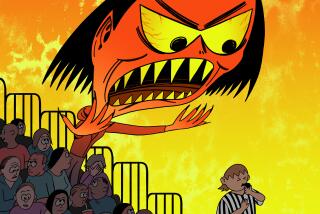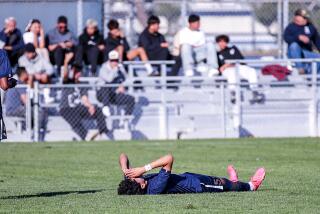Report on sports concussions in kids calls for more study
As American children play team sports in greater numbers and with growing intensity, their risk of getting a concussion has grown but the science of preventing, diagnosing and treating this increasingly frequent brain injury remains maddeningly incomplete, a group of experts warned Wednesday.
Although mounting concern over traumatic brain injury has spawned high-tech imaging techniques, helmet-mounted accelerometers and sideline concussion tests, these have yet to show they can reduce sports-related concussions, the Institute of Medicine concluded in a 286-page report.
Simple steps — including enforcing game rules and fair-play policies already in place — show clear signs of reducing a wide range of sports-related injuries, including concussions, the panel said. For instance, several studies have found that enforcing penalties for helmet-to-helmet contact in football and blind-side hits in hockey and lacrosse reduce concussions as well as the smaller impacts that rattle the brain, with more uncertain consequences.
“Oftentimes the simplest solution is the best solution,” said UCLA neurosurgeon Dr. Mayumi L. Prins, one of the report’s authors. The science that could guide prevention efforts and better care “has a long way to go,” she added.
A year in the making, the comprehensive report also concludes that young athletes have embraced a culture of competitive sports and are reluctant to report symptoms of brain trauma out of fear that it will keep them on the sidelines.
“Athletes profess that the game and the team are more important than their individual health and that they may play through a concussion to avoid letting down their teammates, coaches, schools and parents,” the panel reported.
By setting children up for a slower recovery from concussion and putting them at greater risk of further injuries, this “culture of resistance” endangers their well-being, the report says.
State laws, rule changes in youth sports leagues and public health awareness campaigns have begun to have a positive effect, the panel said. But, it added, “the culture shift is not complete.”
Starting in elementary school and continuing through college, American students should be the target of “large-scale efforts to increase knowledge about concussions and change the culture (social norms, attitudes and behaviors) surrounding concussions,” the group recommended.
Nationwide, sports- and recreation-related brain injuries affect between 1.6 million and 3.8 million people a year, and there’s evidence that the population of young victims is on the rise.
A 2011 study prepared for the Centers for Disease Control and Prevention found that between 2001 and 2009, the number of Americans younger than 19 treated each year for such concussions rose to 250,000 from 150,000. And a National Collegiate Athletic Assn. survey of 15 college sports recently showed that between the academic years 1988-89 and 2003-04, the overall reported concussion rate doubled, from 1.7 to 3.4 concussions per 1,000 “athletic exposures.”
“The findings of our report justify the concern about sports concussions in young people,” said Dr. Robert Graham, the chairman of the Institute of Medicine committee and a healthcare quality specialist at George Washington University in Washington. But, he added, “we need more and better data” to guide young athletes and their families, coaches and physicians in taking measures to reduce their risk of harm.
Stories of retired professional football players hobbled by depression, cognitive decline and early dementia have driven concerns that early participation in contact sports may expose children to multiple concussions before they even leave high school.
In many cases, school systems and youth leagues have responded by limiting the number of weekly practices at which full contact is allowed; requiring student athletes to undergo baseline cognitive testing that helps doctors determine when an athlete has recovered enough to return to play; and implementing compulsory concussion-training for coaches and parents.
Football, ice hockey, lacrosse and wrestling were identified as the sports most likely to produce concussions. But the Institute of Medicine report emphasizes that for young athletes, it’s not just the sport that dictates concussion risk; as they mature, players’ skill, speed, gender and brain development all influence the likelihood of brain injury and of a protracted, difficult recovery. Researchers should undertake a broad effort to tease out those factors both to inform athletes and their families and to ensure that protective gear and measures go to those who need them most, the report says.
At the same time, the panel acknowledged that biomedical research currently offers no help in setting limits on the number and strength of “hits” a young athlete can safely sustain, and in determining whether limiting full-contact sports practices is sufficient to protect a child.
Even as the National Football League reached a tentative settlement with retired players, the Institute of Medicine panel underscored that the long-term effects of one or more concussions are inconsistent. It “remains unclear” whether repetitive head impacts or multiple concussions sustained in youth cause neurodegenerative diseases dozens of years later, the panel wrote.
Even the diagnosis of chronic degenerative encephalopathy — the term used to describe anomalies seen in the autopsied brains of dozens of former athletes — is problematic, the committee wrote.
The panel also cited “limited evidence” that current helmet design reduces concussion risk, and warned that the makers of head gear and mouth guards are marketing their wares “without sufficient scientific foundation” for claims that they reduce concussions.
That underscores the finding of research presented this week at the national meeting of the American Academy of Pediatrics that showed negligible differences in concussion rates among 1,332 high school football players wearing three different brands of helmet.
While praising the Institute of Medicine’s focus on changing the culture of youth sports, activist Brooke de Lench said the report gave short shrift to the value of helmet-based sensors that measure impact to the head.
High-tech sensors attached to helmets and other gear “will revolutionize how we monitor players in all sports,” said De Lench, producer of a PBS documentary, “The Smartest Team: Making High School Football Safer,” airing this fall. She added that such technology can help counter a young athlete’s resistance to being taken off the field by giving coaches an objective measure of a blow to the head.
ALSO:
Study: No helmet brand can save football players from concussion risk
Post-concussion return to learning also a tough decision
NFL players’ brains at work show early signs of concussions’ toll







